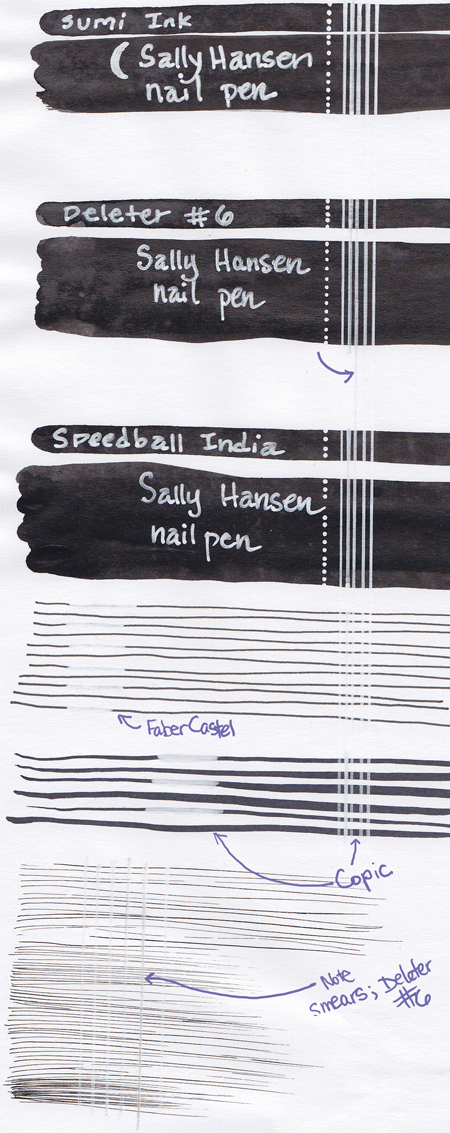Sally Hansen Nail Art Pen, White: recommended
I’m still slowly working on my Great Inking Project wherein I review the black drawing inks in my stash, but in the meantime, I ran across a fabulous white ink and wanted to rush to tell everyone about it.
As some of you know by now, I am wee bit obsessed with ink. In drawing comics or manga, which admittedly I do only as a hobby, I primarily use black ink on white paper, but like many (most) artists, I also use white ink to add highlights, correct marks, or do various techniques.
The problem is that white ink does not behave like black ink (which dyes paper, among other things). There are several white ink options available, but most of them are more paint than ink, since it’s very difficult to get good opaque coverage with fine white liquid. I’ve used the usual White-out, Copic white, and various white inks. There are several problems with these: one must use a brush or sponge and the lay-down of the ink/white-out is gloopy thick and thus makes making marks over it again in black rather difficult or the white ink is smooth but covers not a whit.
I’ve also tried various correction pens in white. Correction pens are such a lovely idea. Unfortunately, they either suck or they give me a vicious headache. Or both.
Which is why when I ran across this nifty little white pen, I was so pleased I had to share as soon as possible. This is a white ink pen, has no discernable smell (to me), lays down good coverage, creates smooth lines that could easily be covered over (ie, is not goopy whatsoever), and generally behaves like a dream. You have to buy it in the nail polish section of the drugstore instead of an art supply shop, but such are the trials and tribulations of being an artist. Unlike many white-pens, the tip is quite fine and it does not have a maximum number of purchases or other anti-graffiti or anti-huffing retail restrictions, at least in my state.
Below you will find the results of my trial. I took three kinds of ink and laid down thick dark swathes. I used two kinds of pens and made lines. Finally, I used a single drawing ink and made very fine effects lines. Then I used the white pen over each of them.
I used three kinds of ink for the swathes. The first is a Sumi ink (you can tell it is not rich, extra-dark black). The second ink is, I believe, alcohol based, but I cannot be certain because it is Japanese; it is however, alcohol soluble when dry but not water soluble when dry. It’s called Deleter #6 and is my favorite drawing ink. The final ink is an India type ink, which is not water soluble or alcohol soluble when dry; (this particular India ink is Speedball).
The marker/pen lines are first, Faber Castel pen in size small, black. The second is a brush-nib Copic.
The effects lines are done with Deleter #6 and my trusty G-nib, because those are my favorites.
Going from top to bottom, you’ll notice that the Sumi ink isn’t all that black, and that the white pen covered it pretty well.
The Deleter #6 is darker ink, but the white covered it OK when writing/highlighting but began to smear, especially during the line marks.
The Speedball India Ink is the darkest of the inks, and the white pen covers it the best. Unlike the Deleter, there is no smearing whatever.
The first set of marking pens is the Faber Castel and the white pen covered the marks pretty well, but might have benefited from a second coat.
The second set of marking pens is the Copic, and you can begin to see more smearage and poor coverage.
The final set of effects lines shows the worst of the smearing. That was done with the Deleter.
As far as I can tell, this white pen does very, very well on any ink except that which is alcohol based. If you use a Sumi style or an India style, you should be just fine. If you want to do some minor, very fine correction work on an alcohol based ink (because you’re addicted, like me, to Deleter #6 or Copics or for some other reason) you may find it usable with some tweaking. 
